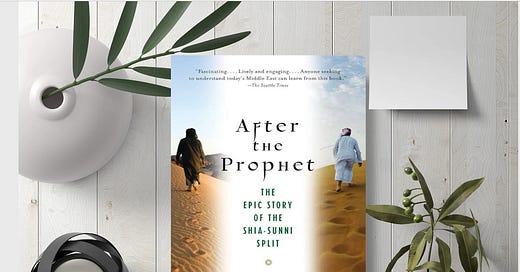Hundreds of books have been written about the division between Shii and Sunni Islam, but After the Prophet by Lesley Hazleton stands out as one of the most compelling and well-researched accounts on this subject. In just three chapters, Hazleton provides a concise yet profound exploration of the historical, theological, and political origins of this schism. Having lived in the Middle East, she brings a unique perspective, blending history with a narrative style that makes the past come alive.
This article highlights some of the most important themes covered in the book. Without further ado, let’s dive in.
1. The Succession of the Prophet
One of the central themes of the book is the issue of succession following the death of Prophet Muhammad. Hazleton begins by recounting the Prophet’s final days when, according to historical accounts, he requested a pen and paper to write down his wishes. However, those present in the room did not comply with his instructions. This moment, famously known as the “Pen and Paper Incident,” remains a significant point of contention between Shias and Sunnis.
Shia Muslims believe that the Prophet designated Imam Ali as his successor during his lifetime, citing various events as evidence, including:
Dawat-e-Ashira (the first public proclamation of Islam, where the Prophet announced the message of Islam to his family),
The Night of Migration (when Ali risked his life by sleeping in the Prophet’s bed when he was migrating from Mecca to Medina), and
Ghadir Khum (a gathering after the Prophet’s final pilgrimage, where he is said to have publicly declared Ali’s leadership).
Shias argue that despite these indications, the Prophet’s family was deprived of its rightful leadership after his death, and power was usurped.
Sunnis, on the other hand, believe that the Prophet did not explicitly appoint a successor. Instead, after his passing, a shura (consultative council) was convened in Medina to decide on the new leader. The Ansar (inhabitants of Medina) initially argued that leadership should belong to them, given their role in protecting the Muslim community. However, Abu Bakr, supported by Umar, asserted that the leader must be from the Quraysh tribe. After hours of deliberation, marked by rising tensions and even physical confrontations, Umar took allegiance at the hands of Abu Bakr, making him the first Caliph. This event, known as the Saqifa Bani Sa’ida, remains a key point of difference between Sunni and Shia perspectives.
2. Hostile Relations Between Ali and Ayesha
Ali, the Prophet’s cousin and son-in-law, and Ayesha, the Prophet’s favorite wife, had a strained relationship, which Hazleton examines in detail. Several incidents contributed to this animosity:
Jealousy and Family Dynamics: The Prophet had children only with Khadija, his first wife, and Fatima, his daughter from Khadija, was married to Ali. Their sons, Hasan and Hussain, were deeply cherished by the Prophet. Ayesha, being much younger and childless, may have felt a sense of rivalry and exclusion.
The Necklace Affair: During a journey, Ayesha lost her necklace and was inadvertently left behind. A young soldier named Safwan later escorted her back to Medina, sparking rumors against her. When the Prophet sought advice, Ali suggested that he divorce Ayesha, further straining their relationship.
This personal animosity ultimately escalated into a major political conflict: the Battle of the Camel. Ayesha led an army against Ali, resulting in a brutal civil war within the Muslim community. Hazleton highlights how personal grievances evolved into larger political battles, influencing the course of Islamic history.
3. The Tragedy of Karbala and the Consolidation of Shii Islam
Perhaps the most defining moment in Shii history is the Tragedy of Karbala, which Hazleton explores in depth. When Yazid, the son of Mu’awiya, assumed the caliphate, many Muslims, particularly in Kufa, opposed his rule and invited Husain, the grandson of the Prophet, to challenge his authority. However, the Kufans abandoned their promises out of fear, leaving Hazrat Husain and his small group of 72 companions, including women and children alone against Yazid’s army.
What followed was a massacre. Hazrat Husain and his family were brutally martyred, an event that deeply shaped Shii's identity. Hazleton argues that this tragedy was a turning point, solidifying Shii Islam’s religious doctrines and its emphasis on martyrdom, justice, and resistance against oppression. Even today, the annual commemoration of Karbala remains central to Shia religious observance.
The Lasting Impact: From History to Modern Politics
Hazleton doesn’t just recount history, she connects it to contemporary conflicts. She discusses how the Sunni-Shia divide continues to shape global geopolitics, particularly in the rivalry between Saudi Arabia (Sunni) and Iran (Shia). What began as a dispute over leadership has since transformed into a complex web of political, cultural, and religious identities that continue to influence the Muslim world today.
Written in an engaging and accessible style, After the Prophet serves as both a historical account and a reflection on modern conflicts. Hazleton’s balanced approach avoids taking sides, instead offering a nuanced perspective on how faith, power, and history intertwine.
By transforming a book full of historical facts into a vivid and emotionally resonant narrative, Hazleton ensures that readers, whether familiar with Islamic history or new to the topic, gain a deeper understanding of one of the most enduring and consequential divisions in religious history.



